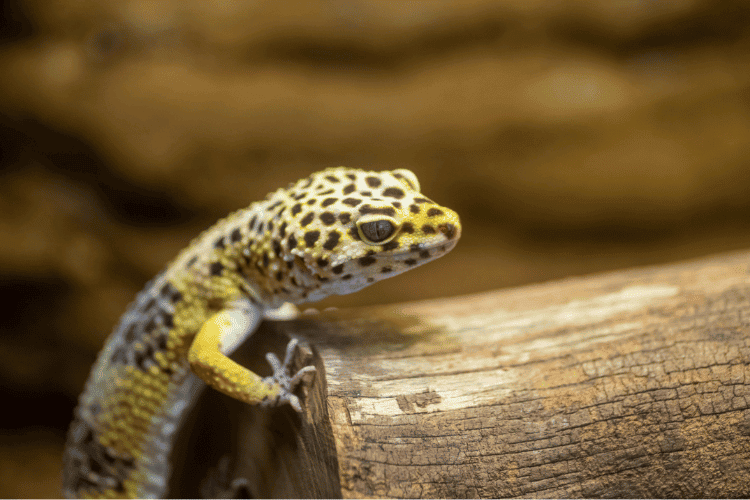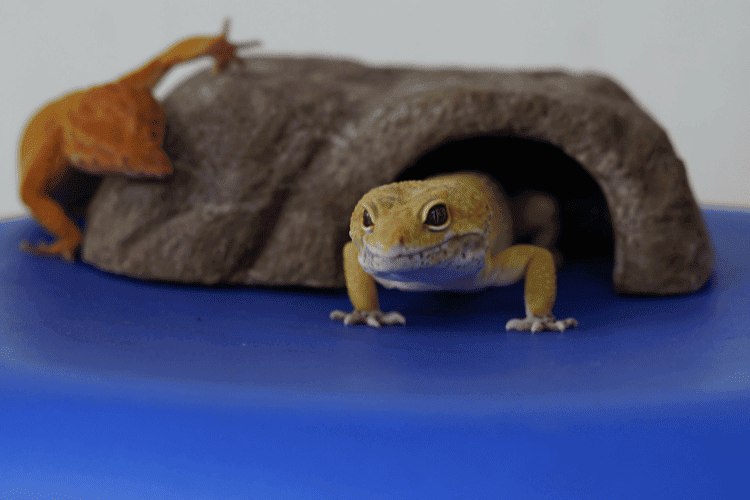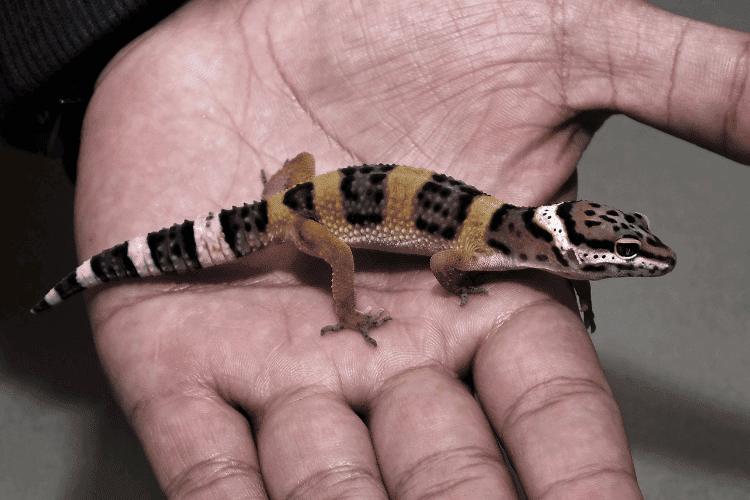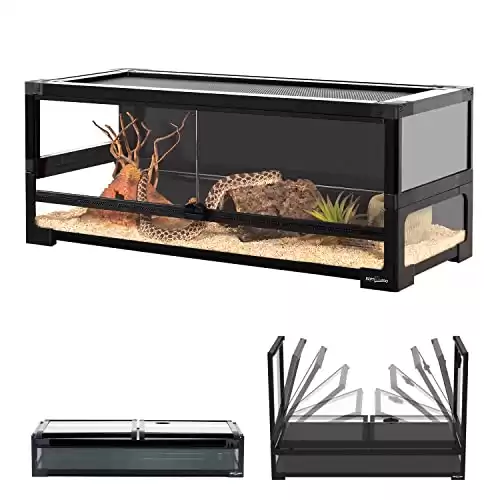
It was a long day at work and you finally came home to relax. You take a shower, treat yourself to a hearty meal, check on your pet lizard, and…it’s splooting?
Splooting is for cats and dogs, isn’t it? Why is the leopard gecko splooting? What’s going on? Let’s find out.
What Is Gecko Splooting?
Splooting is a rather common behavior observed in leopard geckos, where they lay flat with their legs stretched out.
This posture helps them absorb maximum heat from their environment. While some might worry about its odd appearance, splooting is a common way for these reptiles to regulate their body temperature and find comfort.
Should You Worry if Your Leo Is Splooting?
While splooting is a normal behavior in leopard geckos, it’s not always a good thing to see your Leo splooting.
You must keep an eye out for other signs that are accompanying the splooting behavior. That way, you’ll be able to tell if the splooting is a good or a bad sign.
When Is Splooting a Normal Behavior?
Here’s when a splooting gecko is just another Tuesday:
The Gecko Is Retaining or Absorbing Heat
Heat retention and absorption are key reasons why leopard geckos sploot. These crepuscular-nocturnal creatures flatten themselves to maximize heat absorption from their environment.
Similar to basking reptiles, splooting helps them warm up naturally. When healthy, this behavior is a normal response to regulate body temperature.
There Are No Unusual Behaviors
Leopard geckos exhibiting consistent and predictable behaviors generally indicate splooting as a normal action.
Owners should observe for any unusual signs of restlessness, erratic activity, or changes in temperament. If these behaviors are absent and the gecko maintains its routine, there’s usually no need for concern when you see your gecko’s belly cleaning the floor.
Defecation Is Normal
If your leopard gecko maintains regular bowel movements with normal poop consistency and appearance, splooting is often a non-issue. Monitoring the color and texture of excretions, including brownish or black feces with white urates, helps ensure the gecko’s digestive health.
As long as the gecko’s waste output remains consistent and healthy, splooting can be seen as a natural posture related to heat absorption rather than a cause for concern.
They Have a Good Appetite
If your gecko is gulping his meals like there’s no tomorrow, then it’s a positive indicator that splooting is likely a benign behavior. If the gecko continues to eat regularly, consuming its meals with enthusiasm, it suggests overall well-being.
That’s because a strong appetite reflects the gecko’s ability to maintain its energy levels and function optimally. When accompanied by other signs of vitality, such as active behavior and proper digestion, a good appetite reinforces the normalcy of splooting in leopard geckos.
Your Gecko Has Normal Levels of Activity
Observing a leopard gecko engage in its typical activity levels can reassure owners that splooting is within the realm of normal behavior. Geckos that maintain their usual levels of movement, exploration, and interaction exhibit a healthy balance.
Active periods followed by resting, including splooting, are indicative of a gecko’s ability to regulate its energy expenditure. As long as the gecko remains active, curious, and responsive, splooting can be considered a natural part of its behavior.
Geckos Just Sleep in Odd Positions

Leopard geckos are known for their quirky sleeping habits, often choosing unconventional positions for rest. This odd behavior extends beyond splooting to various spots and surfaces within their habitat.
While these sleeping postures may seem uncomfortable to human observers, geckos find warmth and coziness in these positions. As long as they maintain their health and other normal behaviors, sleeping in unconventional locations is a testament to their adaptability to diverse environments.
In other words, if you find your gecko with its belly on a branch and all the limbs are dangling, your proper reaction should be just laughter. Of course, this is assuming that all the healthy signs mentioned above are present.
When Should You Worry if You See Your Gecko Splooting?
Here’s when splooting could be a sign of concern:
There Are Digestive Problems
Digestive problems, such as impaction or constipation, can trigger splooting in leopard geckos. When these reptiles experience stomach discomfort due to digestive issues, they may adopt the splooting stance to alleviate pain.
Geckos might remain still for extended periods, attempting to reduce discomfort. Recognizing this behavior, along with other symptoms we’re about to mention, is crucial to understanding when digestive problems are causing your gecko to sploot.
Your Gecko Is Sick
Illnesses affecting leopard geckos, particularly those impacting their immune system, can lead to increased splooting. When geckos are unwell, they often exhibit lethargy and remain inactive for extended periods.
Frequent splooting combined with other symptoms may indicate an underlying health issue that requires veterinary care.
Monitoring your gecko’s behavior, such as unusual levels of rest and splooting, can help you identify potential illnesses and ensure prompt medical attention for your pet’s well-being.
Your Gecko Is Stressed Out
Stress is a significant concern for leopard geckos, both in captivity and in their natural habitat. Factors like inadequate heating, improper diet, and disruptions to their environment can contribute to stress-induced splooting.
Chronic stress may lead to unusual behaviors, including frequent splooting, as geckos attempt to find comfort.
Recognizing and addressing potential stressors, such as loud noises or temperature fluctuations, can help mitigate the risk of splooting due to stress and ensure your gecko’s well-being.
Your Gecko Is Trembling
Observing your leopard gecko trembling while splooting is cause for concern and may signal underlying issues. Trembling could result from temperature problems, dietary deficiencies, or other factors affecting their well-being.
It’s crucial to address these issues promptly, as persistent trembling may indicate discomfort or distress. Providing a stable and suitable environment, along with proper veterinary care, can alleviate these symptoms and ensure your gecko’s health and happiness.
Your Gecko Has Mobility Issues
When a leopard gecko struggles with splooting and experiences difficulty in moving, it might be grappling with mobility issues such as constipation or impaction.
These conditions can place pressure on the gecko’s spinal nerves, causing pain and hindering movement.

As a result, the gecko may show reluctance to move, exhibit dragging movements, or even resort to both behaviors. This discomfort can contribute to the frequent adoption of the splooting posture.
Making Sure That Your Geckos Are Healthy
If you want to never worry about seeing your Leos splooting, then you have to ensure their health at all times.
Provide them with a proper diet. Leopard geckos are insectivores, so their diet should consist of a variety of live insects, such as crickets, mealworms, and waxworms. You should also dust the insects with
Further, keep their enclosure clean and well-maintained. The enclosure should be the right size for your gecko and should have a variety of hiding places. The substrate should be easy to clean and should not be dusty.
The temperature and humidity levels in the enclosure should be kept within the recommended range.
Don’t forget to take your gecko to the vet for regular checkups. This is especially important for young geckos and geckos that are sick or injured.
Monitor your gecko’s behavior and appearance for any signs of illness. Some common signs of illness in geckos include:
- Weight loss
- Diarrhea
- Lethargy
- Discharge from the eyes or nose
- Loss of appetite
- Difficulty breathing
- Skin problems
If you notice any of these signs, it’s important to take your gecko to the vet immediately.
Last but not least, you may want to provide your gecko with a heat mat in the colder seasons. Your gecko may be healthy but still failing to keep warm. In such a case, a heat mat will be just the thing he needs.
The Verdict
In most cases, seeing your gecko splooting is just like seeing them do any other activity. As long as the gecko is behaving normally, eating well, and moving around regularly, then splooting is just a short break for a happy gecko.
However, if you notice splooting among any negative signs like improper defecation, lack of appetite, or trembling while splooting, then your gecko is distressed. In that case, a vet visit is required.


